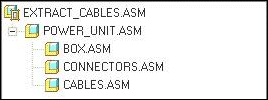About an Extract Assembly
An extract assembly is a subset of an assembly. It contains only those components that you select from the original assembly. All changes that you make to the extract assembly components automatically appear in the original assembly. Similarly, all changes that you make to the original assembly automatically appear in the extract assembly. All external references created in the extract assembly are automatically mapped according to the structure of the original assembly.
You can use an extract assembly to perform concurrent cabling designing by quickly setting up an environment that contains only the cabling subassemblies that you want to work on and the required reference components.
You can also use an extract assembly to work only with several particular components of a large assembly by including only the required components in the extract assembly. As only the components included in an extract assembly need to be retrieved, time required for retrieval of components is significantly reduced.
For example,
The following is the Model Tree of the original assembly, POWER_UNIT.ASM.
The following is he Model Tree of the extract assembly, EXTRACT_CABLES.ASM. POWER_UNIT.ASM is the first-level subassembly of EXTRACT_CABLES.ASM.
You must set the first-level subassemblies of the extract assembly as modifiable. If you do not set the first-level subassembly is as modifiable or there are more than one first-level subassemblies, the Cabling application is not available for the extract assembly. You may set a subassembly as reference only to avoid any unintentional modification to the subassembly and its components.
You can discard an extract assembly anytime without affecting the original assembly in any way.


